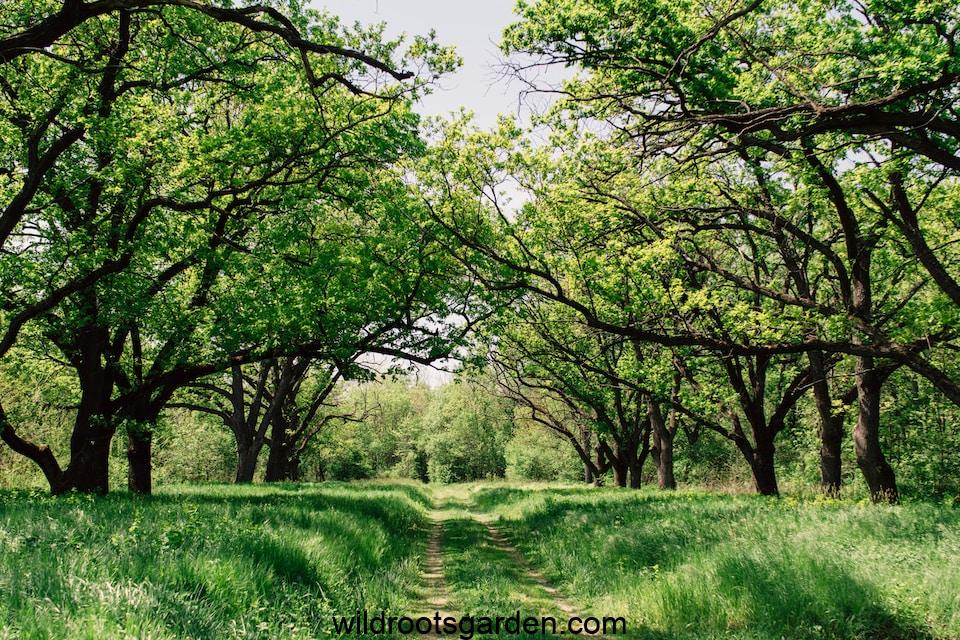Top 12 Fastest Growing Oak Trees. Oak trees stand out as a superb landscaping option since they provide both grandeur and usefulness. a desire for rapid expansion and the temptation of shade Look nowhere else. With up to 36 inches of growth per year, the Japanese Evergreen Oak and Nuttall Oak stand out as the champions of speed. These magnificent trees can grow up to six centuries old and reach heights of more than 100 feet.
Oak trees, with their stately silhouettes and enduring spirit, have captivated humanity for millennia. They offer not just shade and majesty, but also vital roles in our ecosystems and a tangible connection to the past. But have you ever considered welcoming an oak into your own life?
This article explored the diverse tapestry of fast-growing oaks, each a potential companion on your verdant journey. We unraveled the factors that influence their growth, delved into their unique personalities, and unveiled the ideal conditions for them to thrive.
Plant an Oak: Let this robust symbol of longevity grace your yard, park, or any open space that yearns for a touch of nature’s grandeur. Imagine future generations basking in its shade, squirrels flitting through its branches, and autumn’s vibrant palette splashing across its leaves.
JUMP TO TOPIC
- 1 Table of Contents
- 2 Are Oak Trees Rapid Growers? Unveiling the Growth Dynamics
- 3 Unveiling the Swiftest Growers: 12 Oak Trees on the Fast Track
- 4 Japanese Evergreen Oak: A Swift Journey Beyond Borders
- 5 Southern Live Oak: A Southern Emblem Reaching Beyond Bounds
- 6 Valley Oak: California’s Native Marvel
- 7 Nuttall Oak: Rising Upright, Casting Subtle Shadows
- 8 Southern Red Oak: A Swift Symphony of Spanish Oak
- 9 Water Oak: A Name, a Misconception, and a Triumph
- 10 Pin Oak: A Stalwart Companion in Urban Landscapes
- 11 Coast Live Oak: Majesty in the Moniker
- 12 Canyon Live Oak: Elevation and Charm in Harmony
- 13 Laurel Oak: A Stalwart Stature of Elegance
- 14 Red Oak: A Symphony of Hues, a Song of Endurance
- 15 Willow Oak: The Culmination of Majesty
- 16 Choosing the Premier Oak: Navigating the Choice
- 17 Unveiling the Ideal Oak: A Choice of Wisdom
- 18 Defining Your Dream Oak Tree: Tailoring Nature to Your Desires
- 19 FAQs about Top 12 Fastest Growing Oak Trees:
- 20 Additional Resource:
Table of Contents
Are Oak Trees Rapid Growers? Unveiling the Growth Dynamics
Delving into the realm of tree growth, a pertinent question emerges: Are oak trees bestowed with rapid growth? The narrative beckons us to navigate this query with nuance. While acknowledging the diverse oak species and their varying growth rates, a comparative glance at their counterparts, the maple and aspen trees, offers enlightening insights.
Oak trees, when juxtaposed with their counterparts, exhibit a relatively leisurely pace of growth. Their rhythm is not one of haste, unlike the poplar trees, which can ascend by up to 8 feet in a solitary year, as witnessed in certain species. At the zenith of rapid growth, the Aspen, Maple, and Willow trees reign supreme.
Yet, let’s not be swayed solely by speed. The measured cadence of oak trees doesn’t diminish their significance. Planted with foresight, they evolve into guardians of shade, purveyors of beauty, and wildlife sanctuaries. The passage of time, slow but steady, crafts a legacy that endures.
Unveiling the Swiftest Growers: 12 Oak Trees on the Fast Track
Envisioning a verdant addition to your landscape, the choice of an Oak tree has taken root in your aspirations. The pressing questions arise: How swiftly will this arboreal companion mature? When will the coveted shade grace your surroundings? What stature will it ultimately attain?
Rest assured, for we stand as your guiding light through this foliage-filled journey.
Behold, an anthology of the 12 most expeditious oak trees, each paired with their projected statures. This compendium of knowledge serves as your compass, steering you toward the optimal domains where each oak species thrives. In these insights, you will unearth the blueprint for a tree that not only endures but flourishes across the tapestry of time. Embark on this odyssey of discovery, and let nature’s marvels unfold before your eyes.
| Tree Species | Annual Growth | Lifespan | Full Height | Best Hardiness Zone |
|---|---|---|---|---|
| Japanese Evergreen Oak | 36″ | 2,000 Years | 30′ | 9a–11 |
| Southern Live Oak | 24 – 36′′ | 1,000 Years | 50′ | 7b- 10b |
| Valley Oak | 24 – 36′′ | 300 Years | 130′ | 7 – 9 |
| Nuttall Oak | 24 – 36′′ | 100 Years | 40–60′ | 6 – 9 |
| Southern Red Oak | 12 – 36′′ | 150 Years | 60-80′ | 6 – 9 |
| Water Oak | 24″ | 60-80 Years | 100′ | 6 – 9 |
| Pin Oak | 24″ | 120 Years | 60-70′ | 4 – 8 |
| Coast Live Oak | 24″ | 250 Years | 70′ | 9 – 10 |
| Canyon Live Oak | 24″ | 150 Years | 100′ | 8 – 10 |
| Laurel Oak | 24″ | 50-70 Years | 100′ | 6 – 9 |
| Red Oak | 24″ | 300-500 Years | 90–140′ | 4 – 8 |
| Willow Oak | 13- 24′′ | 100 Years | 40–60′ | 5 – 9 |
It’s a fact widely acknowledged that growth is a dance with conditions. As we delve into the realm of these 12 swift-growing oak trees, we stand at the crossroads of choice, seeking the oak that harmonizes best with our yard, park, or chosen space.
Yet, a caveat: growth, like life itself, bows to the influence of its surroundings. Variability is the essence of nature’s canvas, where factors such as soil quality, sunlight, rainfall, and care interlace their brushstrokes.
Japanese Evergreen Oak: A Swift Journey Beyond Borders
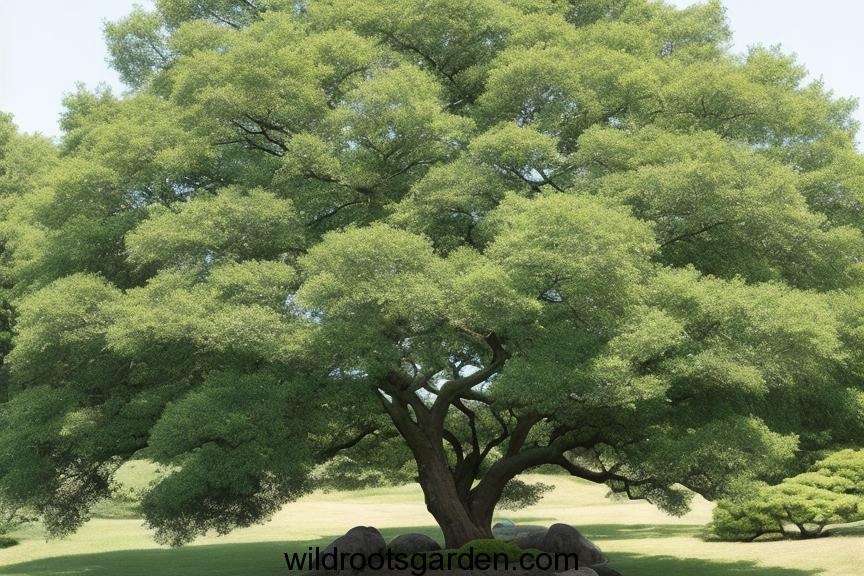
In a twist of nomenclature, the swift-growing harbinger of our exploration isn’t bound by North American roots. The Japanese Evergreen Oak, despite its name, journeys beyond continents and stretches through millennia.
A stride of 36 inches annually paints a portrait of its vitality, yet this tree’s zenith only reaches 30 feet in height. A testament to its haste, a decade or two will usher it into full stature.
The canvas of small yards finds a masterpiece in this oak. It wields the power of shade and branching, unfurling its arms to span up to 20 feet. Adorned with humility, the Japanese Evergreen Oak may not court-applause for its aesthetics or the hues of fall. Yet within its unassuming demeanor lies a guardian of space, a testimony to the passage of time—a steadfast companion.
Southern Live Oak: A Southern Emblem Reaching Beyond Bounds
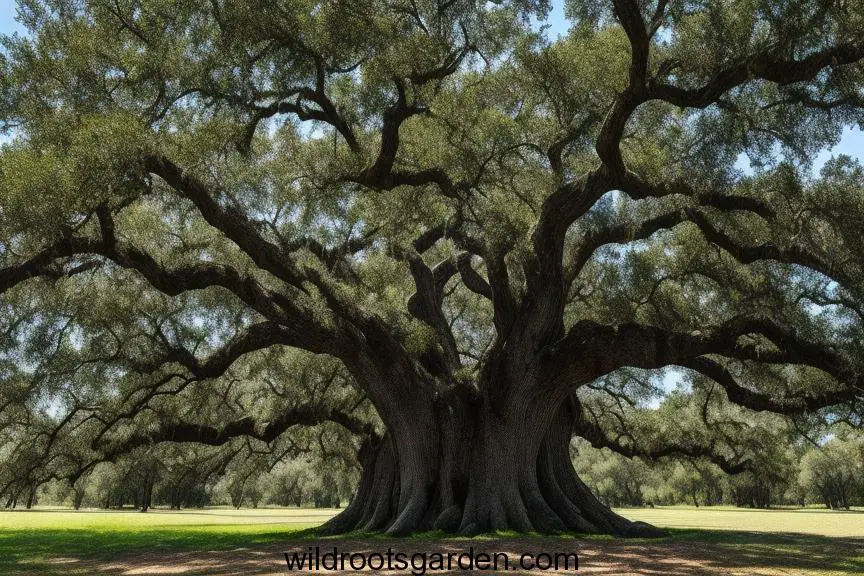
Embodying the spirit of the American South, the Southern Live Oak stands as a testament to the region’s grandeur. With an expansive embrace that defies convention, it reaches skyward and outward, its branches draped in the elegance of Spanish moss.
A stride of 24 to 36 inches each year propels its growth, positioning it among the elite ranks of swift-growing oak trees. Scaling heights of 50 feet, and, on occasion, an astounding 80 feet, the Southern Live Oak’s most remarkable feat lies in its sprawl—a staggering expanse of up to 120 feet in width.
Yet, beneath its shade, a caution echoes. Its yearning for space, as it matures, may manifest in roots that graze surfaces, potentially affecting roads and sidewalks. Resilience to drought, and imperviousness to pests and diseases—these are the hallmarks that adorn this arboreal sovereign.
Valley Oak: California’s Native Marvel
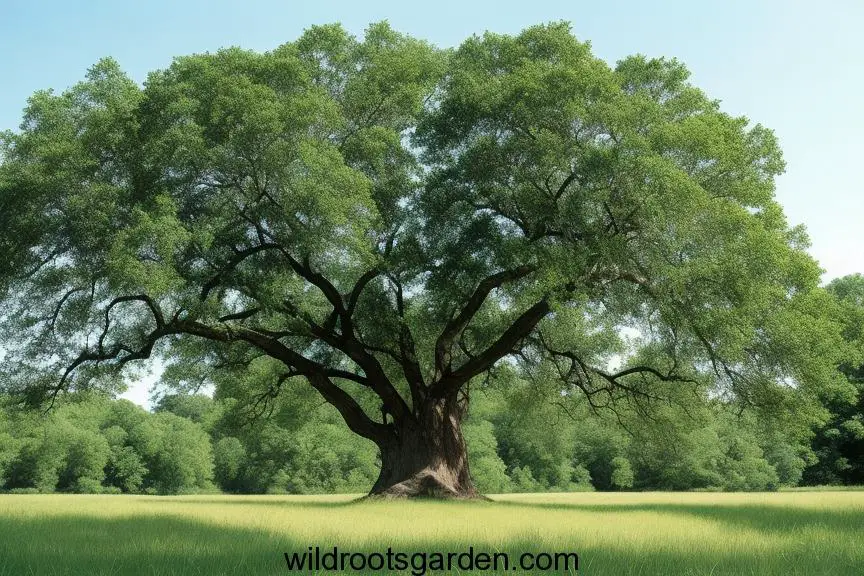
California’s prized treasure, the Valley Oak, emerges as the quintessential native icon. Earning its accolades for velocity, this oak mirrors its life span in years—a testament to its enduring grace.
With each passing year, a crescendo of growth spanning 24 to 36 inches ascends, unfurling a stature that breaches 130 feet in height. Here, the majesty of shade reigns supreme, bestowed by a canopy spanning 50 feet. A symphony of branches gracefully descends to Earth, time’s handiwork weaving a canvas of unparalleled beauty.
Underneath the sun’s ardor, a spacious realm beyond 10 feet is the Valley Oak’s realm of prosperity. It is a reminder that greatness requires breathing room, a dance with the elements that shape its magnificence. The University of North Carolina attests to its potential, for here stands a testament to resilience, growth, and the whisper of time.
Nuttall Oak: Rising Upright, Casting Subtle Shadows
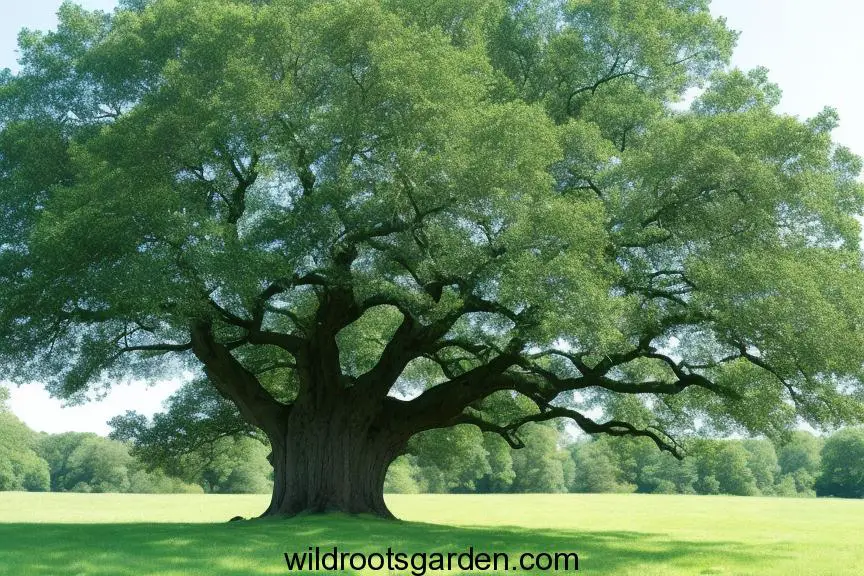
In the orchestra of oaks, the Nuttall Oak stands tall with an upright elegance distinct from its peers, the Valley and Southern Live Oaks. Its crown extends with measured grace, casting a shade more modest in scale.
Growing at a cadence of 24 to 36 inches a year, it ascends to heights of 40 to 60 feet. A nursery’s cherished gem, this oak, due to its facile transplantation and youthful celerity, finds favor among arborists.
A remarkable facet lies in its adaptability—a virtuoso in tolerating diverse soil textures and a medley of pH levels. Resilience courses through its roots, embracing suboptimal conditions with a grace that echoes its upward thrust.
Southern Red Oak: A Swift Symphony of Spanish Oak
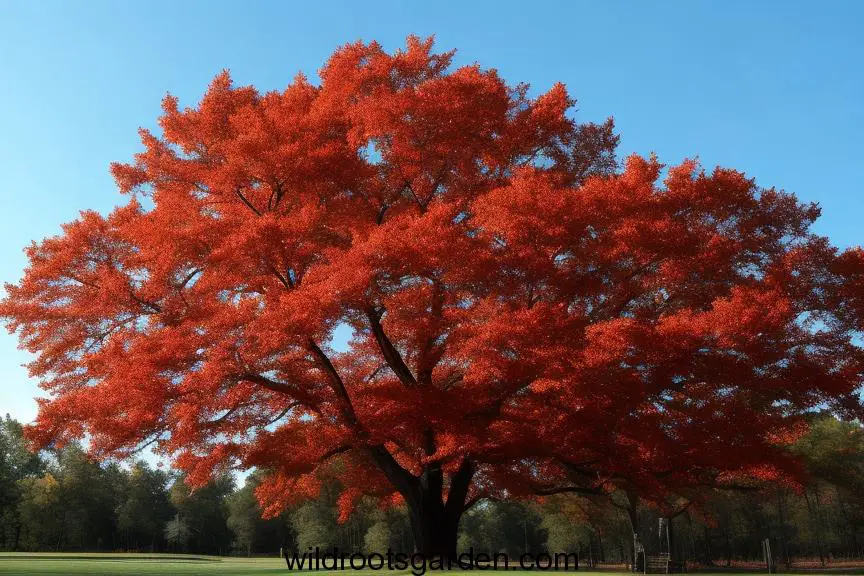
Distinct from its Southern Live Oak counterpart, the Southern Red Oak dances to a swift tempo, aptly christened the Spanish Oak.
Its growth, a harmonious symphony spanning 12 to 36 inches annually, crescendos to heights ranging from 60 to 80 feet. A tenure of 150 years, crowned by a shade that unfurls up to 70 feet, adorns its legacy.
Within its branches lies a sanctuary immune to the ravages of pests and diseases that assail its kin. A devotee of the sun’s caress, it flourishes in well-drained soil that isn’t clay, a testament to its adaptable spirit. As acorns adorn its boughs, a choreography unfolds, a ballet of attraction for creatures who share its habitat. Amidst the rustle of leaves, the Southern Red Oak stands—a testament to vitality, endurance, and the embrace of nature’s embrace.
Water Oak: A Name, a Misconception, and a Triumph
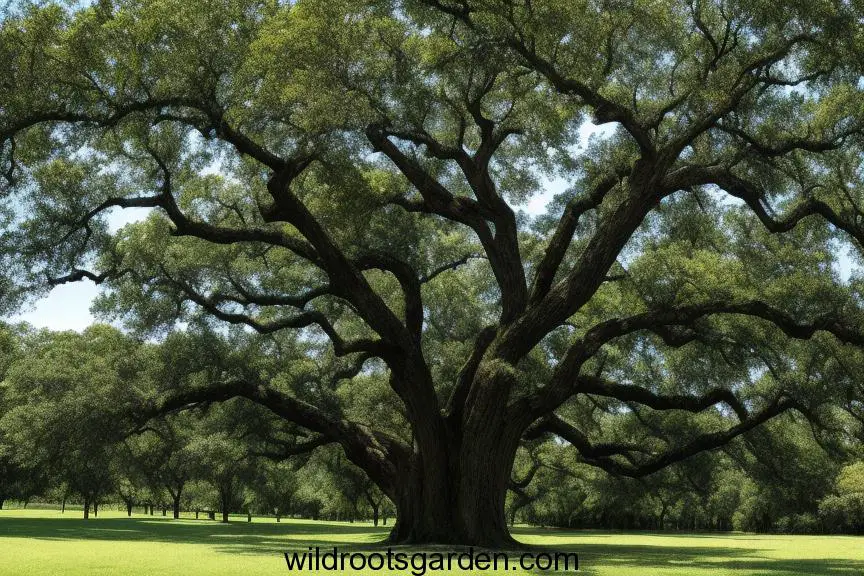
A name can be a curious guide, and so it is with the Water Oak. Defying its moniker, it thrives beyond the realm of wetness, yet harbors a fondness for the proximity of streams and waterways. Native to the southeastern lands, it extends its embrace from Washington to New Jersey, a sentinel spanning the United States.
An upward journey of about 2 feet annually culminates in a stature of 100 feet. However, its lifespan is more fleeting, spanning 60 to 80 years. Within its spread of up to 70 feet, it weaves a canopy of shade.
Behold the acorn—a portrait familiar to many, synonymous with the water oak’s identity. Draped in dark brown, crowned by ridges of a matching hue, it paints the landscape. As autumn ushers in its transformative palette, the water oak turns to a vivid yellow, a marvel of seasonal transition.
Pin Oak: A Stalwart Companion in Urban Landscapes
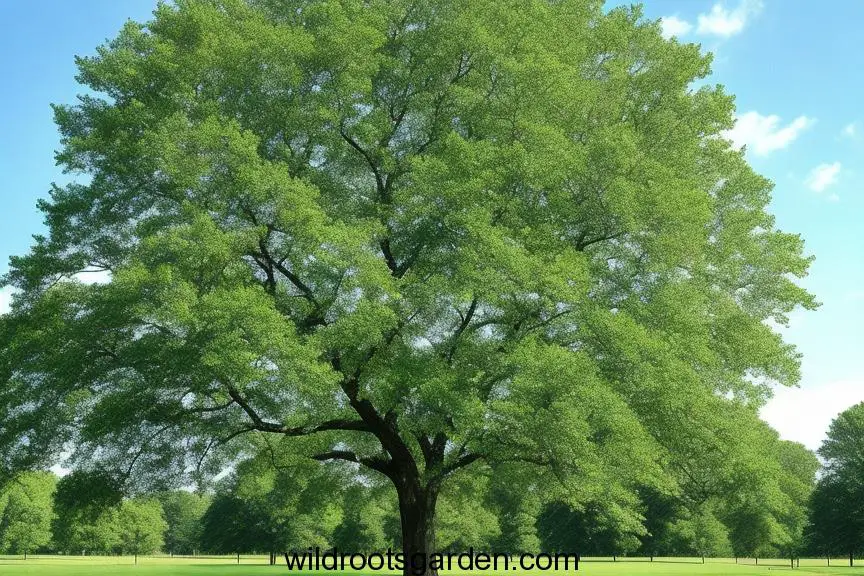
A staple in the urban tapestry, the Pin Oak finds its place in parks, streets, and yards alike. Its popularity resonates in its pyramid silhouette, graced with hues of fall that draw admirers year-round. Even in winter’s grip, its allure remains steadfast, its roots undeterred by affliction.
An ascent of 24 inches each year toward a zenith of 60–70 feet marks the Pin Oak’s trajectory. Its span of shade, spanning up to 40 feet, unfolds a haven beneath its branches. Yet, vulnerability lingers, as susceptibility to branch breakage necessitates a watchful gaze.
Amidst its boughs, a banquet awaits. Acorns, the sustenance of deer, squirrels, and kindred creatures, paint a portrait of interdependence. A testament to nature’s bounty, the Pin Oak graces parks, etching its presence as an emblem of life intertwined.
Coast Live Oak: Majesty in the Moniker
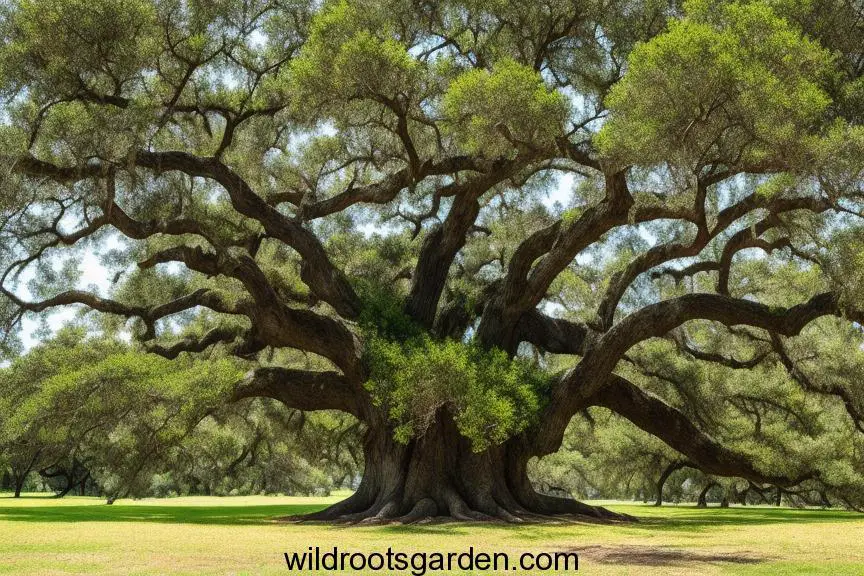
Known by a trio of names—Coast Live Oak, California Live Oak, and Encina—this arboreal marvel graces the landscape with a semblance akin to the southern live oak. A trunk of grandeur, branches that touch the earth with grace—the Coast Live Oak stands as a testament to nature’s artistry.
A measured stride of two feet per year sets the pace, culminating in a crescendo of 70 feet in height. A testament to time’s embrace, its existence is measured in centuries, a storied journey spanning two. Underneath its canopy of up to 70 feet, life thrives in myriad forms—squirrels, birds, and other creatures that find shelter and sustenance within its embrace.
Yet, amidst its allure, shadows loom. Vulnerable to afflictions like sudden oak mortality, it grapples with the duality of importance and fragility, a microcosm of life’s intricate tapestry.
Canyon Live Oak: Elevation and Charm in Harmony
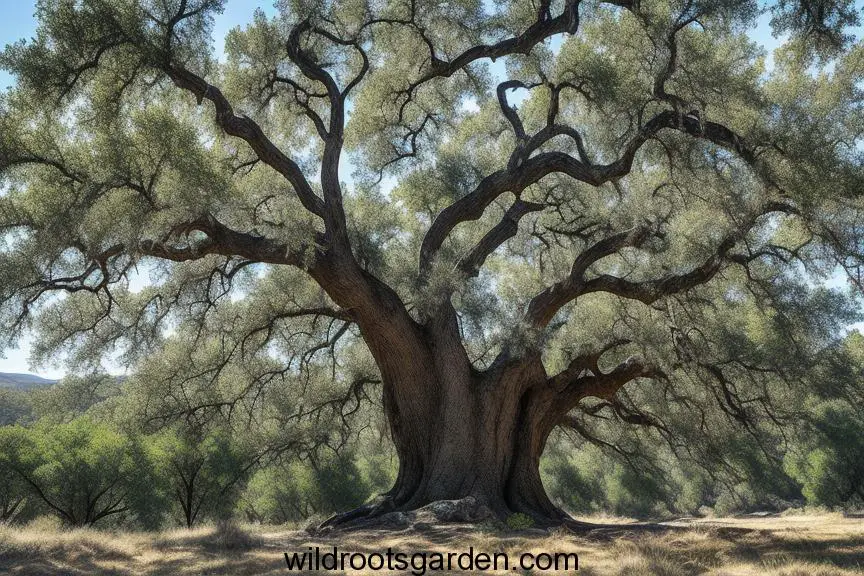
Carved by its name, the Canyon Live Oak finds its haven high amidst mountainous realms. Across the West Coast, from Oregon to Arizona, its presence graces altitudes up to 9,000 feet.
A symphony of growth unfurls, two feet each year, crafting a stature that peers to the heavens at 100 feet. Yet, its embrace spans 20 to 60 feet, with a penchant to stand taller than its girth, lending it a shrub-like charm in select vistas.
Adaptable to soils of diverse temperaments, these oaks find favor in parched lands, like California’s embrace. Their stature might be modest, yet within their branches resides a haven, a realm that nurtures wildlife and extends an invitation for life to flourish. A portrait of resilience, a refuge for the wild, the Canyon Live Oak paints a vignette of nature’s grandeur.
Laurel Oak: A Stalwart Stature of Elegance
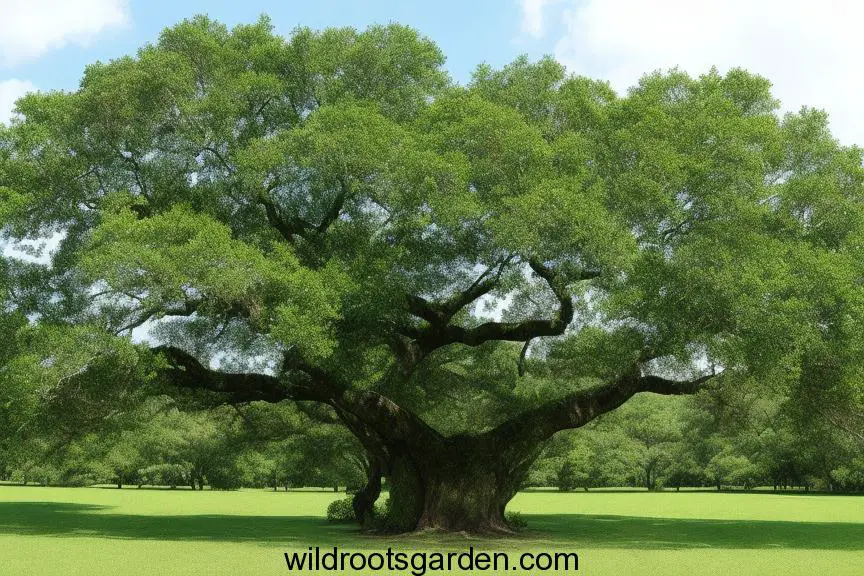
In the verdant tapestry of eastern Texas and the southeastern expanse, the Laurel Oak emerges as a symbol of grace and rapid growth. While it might not match the spectacle of the Pin Oak, its leaves embrace the artistry of autumn’s palette.
A stride of up to two feet per year propels its ascent to heights exceeding 100 feet. A balance between stature and spread is struck with a canopy extending 45 feet, yielding an intriguing harmony. Yet, life’s fleeting nature echoes here, with a span spanning 50 to 70 years.
Within its branches, a bounteous gift awaits—a trove of acorns that beckon squirrels and deer, forging connections amidst the forest’s embrace. A caution whispers through the air, for its branches bear the weight of fragility, a reminder of nature’s delicate dance alongside homes and structures.
Red Oak: A Symphony of Hues, a Song of Endurance
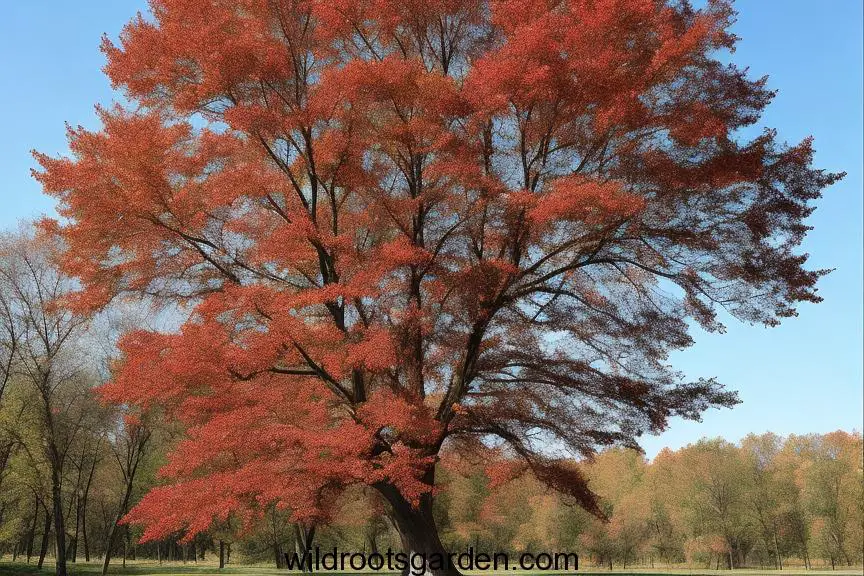
Autumn heralds the crescendo of Red Oaks, their leaves aflame in vibrant reds and oranges, a panorama of nature’s splendor. Beyond aesthetics, these oaks unfurl their majesty across diverse conditions, anchored in well-drained soils.
A journey upwards, two feet each year, unfurls a stature that may soar to 140 feet. Yet, the chronicles of time unravel leisurely, a lifespan that spans up to 500 years. Here, shade is bestowed, and wildlife finds a theater of life in its embrace.
A testament to endurance, a refuge for nature’s melodies, the Red Oak embodies the interplay of form and function, beauty and resilience. Amidst its boughs, seasons change, generations thrive, and the spirit of the oak lives on.
Willow Oak: The Culmination of Majesty
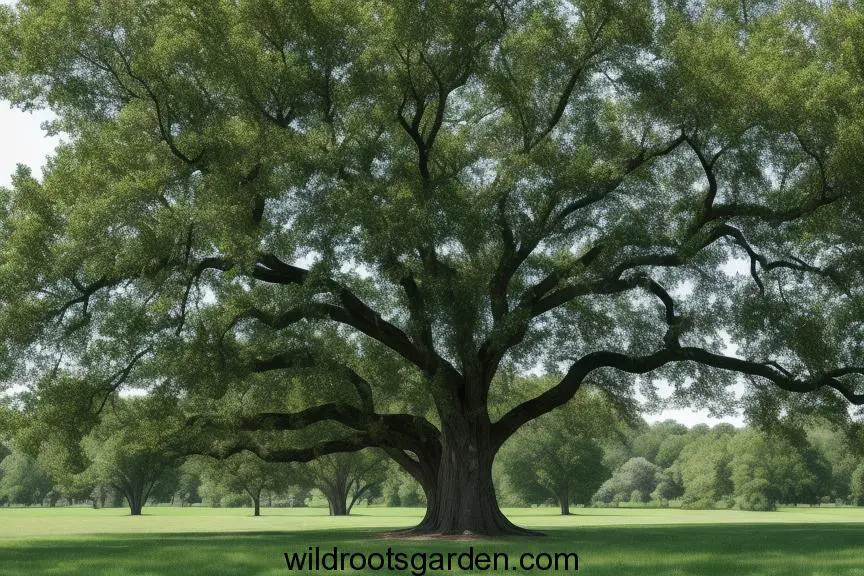
As we near the finale of our exploration, we encounter the Willow Oak—an embodiment of regal stature and ornamental allure. Its presence graces landscapes, a piece of living artistry.
Rising between 13 and 24 inches each year, the Willow Oak’s crescendo reaches a height of 60 feet. In stature, it may be more modest, yet its legacy spans up to a century. Amidst fall’s embrace, a tapestry of yellow and red cascades from its boughs, painting a vivid portrait of transition.
Shade and shelter unfurl beneath the canopy of the Willow Oak, an invitation embraced by small animals and birds. An exemplar of ease, transplanted with grace, it demands minimal upkeep. As you bask in its splendor, remember—this magnificence is yours to enjoy, a testament to the harmony between nature and nurture.
With the decision to plant an oak tree, you tread the path of wisdom. Stalwart and enduring, oak trees stand as sturdy sentinels through time, offering shade to both humanity and the wildlife they nurture.
The oak realm offers a myriad of choices, each endowed with distinct traits. What is the best oak tree to plant? The answer to this inquiry is a journey, a route navigated through thoughtful considerations. To discern the ideal companion, queries must be posed, and nuances explored.
For an in-depth exploration, our guide to optimal oak tree selections awaits. Here, you’ll uncover a tableau of choices, each a piece in the puzzle of nature’s grand mosaic. As you embark on this journey, remember that your choice—an oak tree—bridges generations, is a living testament to your foresight, and embraces nature’s splendor.
Unveiling the Ideal Oak: A Choice of Wisdom
Embarking on the path to plant an oak tree is a decision marked by sagacity. Within the tapestry of nature, oak trees stand resolute—a testament to strength and longevity. Beneath their branches, shade beckons—a sanctuary from scorching summer rays, a refuge for the wild lives intertwined with theirs.
Time is the sculptor of oak trees, shaping them with patient hands. While their growth may unfold at a measured pace, their care is simple, and their legacy is enduring, stretching across the tapestry of generations.
Amidst the choices, the question lingers: Which oak tree is the paramount choice? A conundrum it is, for the oak realm sprawls with diversity. Each oak possesses its allure, its tale to tell. And therein lies the enigma—to decipher the oak that aligns with your aspirations.
To find your answer, a journey of introspection beckons. A few questions will guide your compass. Considerations will weave your path. The quest for the finest oak, one that harmonizes with your vision, unfolds through nuanced inquiry.
For an expanded understanding, delve into our comprehensive guide, a compendium of knowledge that unveils the optimal oak tree for your desires. As you tread this verdant road, remember—your choice of oak, a declaration of partnership with nature, a legacy etched into the embrace of time.
Defining Your Dream Oak Tree: Tailoring Nature to Your Desires
In the verdant realm of oak trees, a symphony of possibilities awaits—each notes a reflection of your aspirations. What stirs your quest for an oak tree? Is it the promise of summer shade, the allure of ornamental grandeur, or the canvas of fall’s glorious hues?
For those yearning for a shaded haven, Live Oaks stands as a formidable choice. With trunks of grandeur and cascading leaves that touch the earth, they weave a canopy that extends even beyond 100 feet.
Impatient for shade? The Nuttall Oak and Japanese Evergreen Oak emerge as swift growers, sprouting at a pace of 3 feet per year—nature’s sprinters.
Fall’s artistic tapestry calls for companions that embrace transformation. Red, Red, and Black Oak trees, alongside Pin and Sawtooth Oaks, unveil a chromatic symphony, transitioning from verdant to a fiery palette of reds, oranges, and yellows.
For those seeking guidance on White, Red, or Black Oak Trees, our guide on planting Oak Trees in Your Backyard awaits your perusal.
Is space limited? Fear not, for options abound even in petite yards. Pin, Nuttall, and Japanese Evergreen Oaks stand as epitomes of grace, reaching a maximum height of 3.5m—a testament to nature’s adaptability.
A yearning for aesthetic splendor beckons. An oak tree that wears the hues of fall, a canvas for autumn decor that beckons admiration from guests.
Seeking solace in colder climes? The northern reaches of the United States beckon for oaks that endure frigid embraces. Scarlet Oaks, White Oaks, Swamp White Oaks, Bur Oaks, and Black Oaks unfurl as guardians, surviving in zone 3 hardiness—withstanding temperatures as low as 40°F.
As the sun blazes in hotter realms, Myrtle Oaks, Cork Oaks, Live Oaks, Holm Oaks, and Japanese Evergreen Oak Trees emerge as sentinels of resilience. In the fiery crucible of 100°F, they thrive in Texas and Florida, defying the elements gracefully.
Thus, the oak tree realm opens its arms—a realm of choices, a tapestry woven from dreams and nature’s bounty. As you navigate the lush corridors of choice, remember—it’s not just about finding an oak tree, it’s about finding your oak tree, a living testament to your desires and nature’s enduring embrace.
When you choose to plant, nurture, or protect an oak tree, you become a part of a timeless story. You contribute to a greener future, provide a home for wildlife, and establish a lasting relationship with nature’s enduring beauty.
Embrace the magic of oaks, and together, let their branches reach toward a brighter, greener tomorrow.
Remember, your decision to plant an oak isn’t just about choosing a tree, it’s about choosing a legacy. So, embark on this verdant adventure, and find your perfect oak companion – a steadfast friend for generations to come.
FAQs about Top 12 Fastest Growing Oak Trees:
How fast do the fastest-growing oak trees grow?
The champions of speed in the oak world can climb up to 3 feet per year! For instance, the Japanese Evergreen Oak and Nuttall Oak offer the quickest ascent, reaching full stature in a decade or two depending on conditions.
Should I plant an oak tree even if I have limited space?
Absolutely! Not all oaks are giants. Oaks like the Pin, Nuttall, and Japanese Evergreen top out at around 35 feet, making them excellent choices for smaller yards.
What are some benefits of planting a fast-growing oak tree?
Besides the quick shade and majesty, fast-growing oaks act as environmental warriors, absorbing carbon dioxide, reducing air pollution, and providing vital habitat for wildlife.
What factors influence an oak’s growth rate?
Sunlight, soil quality, rainfall, and care all play a role. Choosing the right oak for your specific conditions maximizes its growth potential.
Where can I learn more about caring for my oak tree?
Look no further than our website! We offer comprehensive guides on planting, pruning, disease prevention, and everything you need to keep your oak companion thriving for years to come
Additional Resource:
Here are some website resources you can link to in your article, depending on the specific information you want to provide:
Planting and Caring for Oak Trees:
- National Arbor Day Foundation: https://www.arborday.org/
- USDA Forest Service: https://www.fs.usda.gov/
- Arbor Day: https://www.arborday.org/
- The Morton Arboretum: https://mortonarb.org/
Choosing the Right Oak Tree:
- The National Center for Gardening: https://garden.org/
- Gardening Channel: https://www.gardeningchannel.com/
- Sunset Magazine: https://www.sunset.com/
- Dave’s Garden: https://davesgarden.com/
Oak Conservation:
- Arbor Day Foundation: https://www.arborday.org/
- American Oaks Organization: https://www.horseracingnation.com/race/2022_American_Oaks
- The Nature Conservancy: https://www.nature.org/en-us/
- World Wildlife Fund: https://www.worldwildlife.org/
Interactive Plant Finder:
- USDA Plants Database: https://plants.usda.gov/
- Missouri Botanical Garden’s PlantFinder: http://www.mobot.org/gardeninghelp/plantfinder/alpha.asp
- Arbor Day Foundation’s Tree Guide: https://www.arborday.org/trees/index-identification.cfm

